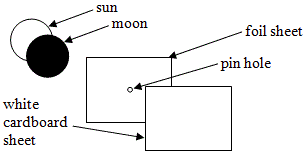|
You are witnessing the early stages of a total eclipse of the sun. The moon has started to cover the sun. Totality will occur late in the afternoon from your vantage point, so the sun is to the west. When it reaches totality, the eclipse can be viewed directly with your naked eye, but before and after totality it is not safe to look at the sun.
You have two ways of viewing the eclipse when it is not at totality:
- You can look directly at the sun through a solar filter. The filter is so dark that all you can see when you look through it is the disk of the sun (partially covered by the moon). About halfway to totality you see something like this:

- You have a pin hole viewing apparatus. The sunlight passes through a pin hole in a piece of foil and 'projects' an image of the disk of the sun (partially covered by the moon) on a section of white cardboard. You look at the cardboard (facing away from the sun) to view the progress of the eclipse. The pin hole acts sort of like a camera lens focusing an image on the cardboard. The following diagram shows the set-up looking toward the west; to see the image on the cardboard, you would have to be on the other side of the cardboard looking east.

You look through the filter at the sun and see that the moon has cut into the sun's disk from the lower right hand corner (we'll call it 4:30 if you imagine the sun as a clock face). If you look at the image on the white cardboard sheet (with the sun at your back), at what clock position will you see the bite removed from the sun's disk?

|

